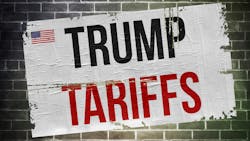Trump’s Tariff Proposals Could Be Very Costly
Perhaps anticipating Donald Trump’s reelection to the US Presidency, on the day before the election the National Retail Federation released a report saying that if new tariffs on imports to the US (as proposed by then-candidate Trump) are enacted, consumers could lose between $46 billion and $78 billion in spending power each year.
The new study looks at how the universal 10-20% tariff on imports from all foreign countries and an additional 60-100% tariff on imports specifically from China would impact these six consumer products categories: apparel, toys, furniture, household appliances, footwear and travel goods.
“Retailers rely heavily on imported products and manufacturing components so that they can offer their customers a variety of products at affordable prices,” said Jonathan Gold, NRF’s vice president of supply chain and customs policy, in a statement. “A tariff is a tax paid by the U.S. importer, not a foreign country or the exporter. This tax ultimately comes out of consumers’ pockets through higher prices.”
The report concludes that even with some U.S. manufacturers benefiting from the tariffs, the gains to U.S. producers and the Treasury from tariff revenue do not outweigh overall losses to consumers.
The organization offered some examples to make their case. A $40 toaster oven would cost consumers $48-$52 after the tariffs. The price of a $50 pair of athletic shoes would jump to $59-$64 and a $2,000 mattress and box spring set would end up costing $2,128-$2,190.
Key findings from the study include:
• The proposed tariffs on the six product categories alone would reduce American consumers’ spending power by $46 billion to $78 billion every year the tariffs are in place.
• The proposed tariffs would have a significant and detrimental impact on the costs of a wide range of consumer products sold in the United States, particularly on products where China is the major supplier.
• The increased costs as a result of the proposed tariffs would be too large for U.S. retailers to absorb and would result in prices higher than many consumers would be willing or able to pay.
• Consumers would pay $13.9 billion to $24 billion more for apparel; $8.8 billion to $14.2 billion more for toys; $8.5 billion to $13.1 billion more for furniture; $6.4 billion to $10.9 billion more for household appliances; $6.4 billion to $10.7 billion more for footwear, and $2.2 billion to $3.9 billion more for travel goods.
• Based on current trade, average tariff rates for all categories examined would exceed 50% in the extreme tariff scenario, up in most cases from single or low double digits.
“A Step in the Wrong Direction”
Looking beyond what a new era of Trump tariffs would do to the US economy, Peter Sand, chief analyst with Xeneta, a Norway-based benchmarking analytics platform for global shippers, said, “Shipping is a global industry feeding on international trade, so another Trump Presidency is a step in the wrong direction.” Importers, he noted, fear another spike in ocean container shipping freight rates.
Sand pointed to ocean and air freight data collected by Xeneta that shows the last time Trump ramped up tariffs on Chinese imports during the trade war in 2018, ocean container shipping freight rates rose by more than 70%.
“The knee-jerk reaction from US shippers will be to frontload imports before Trump is able to impose his new tariffs,” Sand said in a statement. “Back in 2018, the tariff on Chinese imports was 25%; now it is increasing up to 100%, so the incentive to frontload is even greater.”
Sand added, “If you have warehouse space and the goods to ship, frontloading imports is the simplest way to manage this risk in the short term, but it will bring its own problems. A sudden increase in demand on major trade lanes into the US when ocean supply chains are already under pressure due to disruption in the Red Sea will place upward pressure on freight rates.
In Sand’s opinion, Trump’s second presidency could very well reignite the trade war with China and provoke retaliatory action. “In 2018, we saw China respond to US aggression by imposing tariffs of its own, which added even more fuel to the fire, so there is a risk this situation could escalate further in the months and years to come.
“Another Trump presidency will not be welcomed by US importers and exporters, but they needed a swift and clear result in the election. Uncertainty is toxic for supply chains, so at least the industry now has a clearer understanding of the financial and operational risk and can execute the plans they will have prepared in the event of another Trump presidency.”
